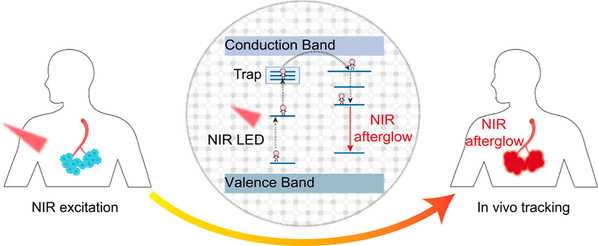Broadband Near-Infrared Light Excitation Generates Long-Lived Near-Infrared Luminescence in Gallates
Shuting Yang1, Bing Qi1, Mingzi Sun2, Wenjing Dai1, Ziyun Miao1, Wei Zheng3,4, Bolong Huang2*, Jie Wang(王杰)1*
1The Key Lab of Health Chemistry & Molecular Diagnosis of Suzhou, College of Chemistry, Chemical Engineering & Materials Science, Soochow University,Suzhou 215123, China
2Department of Applied Biology and Chemical Technology, The Hong Kong Polytechnic University, Kowloon999077, Hong Kong SAR, China
3CAS Key Laboratory of Design and Assembly of Functional Nanostructures, Fujian Key Laboratory of Nanomaterials, and State Key Laboratory of Structural Chemistry, Fujian Institute of Research on the Structure of Matter, Chinese Academy of Sciences, Fuzhou 350002Fujian, China
4Department of Applied Biology and Chemical Technology, The Hong Kong Polytechnic University, Kowloon 999077, Hong Kong SAR, China
ACS Nano, 2024, 18, 22465−22473
Abstract: Persistent luminescence describes the phenomenon whereby luminescence remains after the stoppage of excitation. Recently, upconversion persistent luminescence (UCPL) phosphors that can be directly charged by near-infrared (NIR) light have gained considerable attention due to their promising applications ranging from photonics to biomedicine. However, current lanthanide-based UCPL phosphors show small absorption cross sections and low upconversion charging efficiency. The development of UCPL phosphors faces challenges due to the lack of flexible upconversion charging pathways and poor design flexibility. Herein, we discovered a lattice defect-mediated broadband photon upconversion process and the accompanying NIR-to-NIR UCPL in Cr-doped zinc gallate nanoparticles. The zinc gallate nanoparticles can be directly activated by broadband NIR light in the 700–1000 nm range to produce persistent luminescence at about 700 nm, which is also readily enhanced by rationally tailoring the lattice defects in the phosphors. This proposed UCPL phosphor achieved a signal-to-background ratio of over 200 in bioimaging by efficiently avoiding interference from autofluorescence and light scattering. Our work reported a lattice defect-mediated photon upconversion phenomenon, which significantly expands the horizons for the flexible design of UCPL phosphors toward broad applications ranging from bioimaging to photocatalysis.

链接://pubs.acs.org/doi/10.1021/acsnano.4c07471